Mogalarajapuram Caves Tour Is A Journey Through Vijayawada’s Ancient Rock-Cut Wonders In 2025
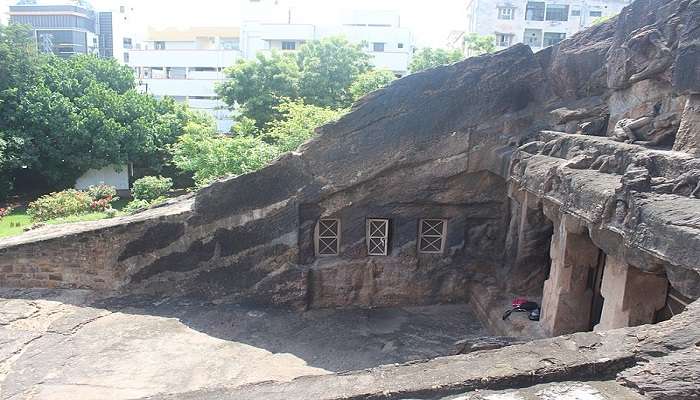
Vijayawada district in Andhra Pradesh has several exotic tourist places. One such unique place is the Mogalarajapuram Caves which were dug out during the Eastern Chalukya region. These five rock-cut caves are dedicated to the Ardhnareshwar profile of lord Shiva. The artwork and iconography are attractive to a lot of tourists who are into history and architecture. This place is perfectly carved with old sculptures of Nataraja, Ganesh, and Ardhanarishvara. The place includes 5 caves out of which only one is preserved to date. The others are either faded or broken over time due to several changes. But still, the place has its own archaeological significance. Let us go in-depth to know what is hidden in them.
Mogalarajapuram Caves History
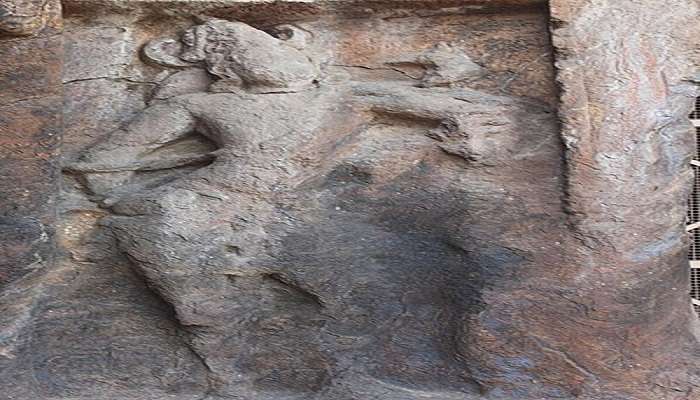
The existence of Mogalarajapuram caves dates back to the 7th century. These caves are well known for their rock-cut sanctuaries and have majestic carvings and sophisticated wall artwork. Out of all the five caves, only one of them is in good condition to date. There are two different theories relating to the construction period of Cave II. According to one theory, since the designs are simple yet equally interesting, some scholars credit the Vishnukundins dynasty of the 6th century for Cave II’s excavation. Others believe its traces to be credited with the Eastern Chalukya dynasty of the 7th century.
Must Read: Temples In Andhra Pradesh
Description Of The Caves At Mogalarajapuram
On excavation, five caves were found at the Mogalarajapuram caves. They might look similar but have different artwork. The details and architectural work of these caves are slightly different. Though the iconography of the caves has faded, they are still a beautiful place to be explored.
1. Cave I
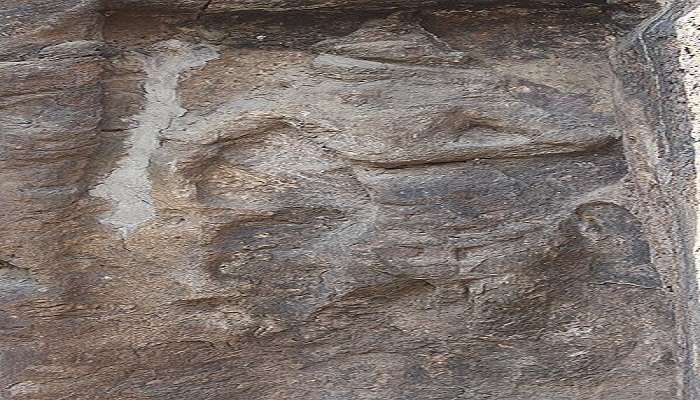
Cave I has a simple design with two pillars, two pilasters, and a facade between them. Each facade has a notch above it. A uttira with bhuta-gana decoration surmounts the square pillars. The interior is more polished, made on a square plane, and consists of three mandapas. They are Mukha mandapa (entrance hall), Maha mandapa (gathering hall), and Ardha mandapa (devotional hall). In front of the cave are two Shaiva dvarapalas, carved on the are the kati-vastras. They represent the clothing style of the 7th century, and these profiles are similar to those found in Pallava and Pandyan rock-cut monuments.
2. Cave II
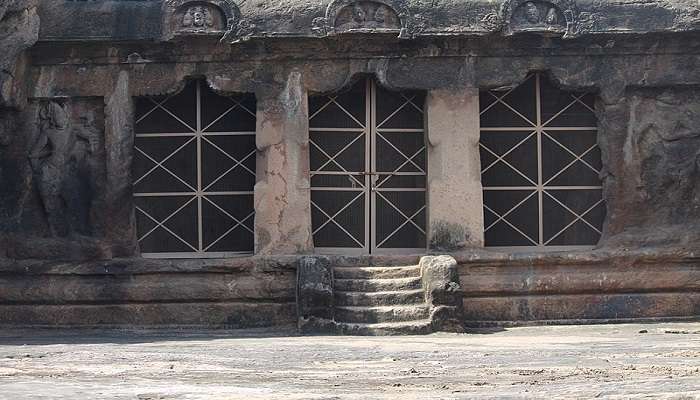
Cave II of Mogalarajapuram Caves is located south of the Shivalayam hills in Vijayawada. A 9-meter rock was cut to build its broad front court. The facade, again, has two pillars and two pilasters, and the mandapa leads to the three sanctums. There are two dvarapalas, with two pillars in between supporting the facade. There are three gavaskas, namely nasika kudus, vyalamukhas, and sakti dvaja, adorning the top of the facade. Its artwork includes lions, elephants, bulls, and some mythical fused animals.
At the top of the rock cave, there is a sculpture of Shiva Tandava. The sculpture has faded, but the three main elements – the damaru, the parasu, and the trishul, can be easily recognized. This sculpture of dancing Shiva is widely known as Nataraja and reflects the Odisha tradition. The pillars, too, have beautiful 7th-century Vaishnava artwork done on them: three pillars, three different stories. The first pillar shows Krishna and Putana legends, the second one is covered with Krishna and Kuvalayapida elephants, and the third one shows the Kaliya-daman legend of Krishna. Chalukyan artists were so talented that they divinely carved their art to pay respect to Shaiva and Vaishnava themes. The stairs between the pillars are small but can occupy a few people. The three sanctums are dedicated to the Hindu trinity – Brahma, Shiva, and Vishnu. The idols of Brahma and Vishnu are missing, but the central sanctum is dedicated to a circular monolithic linga-pitha. Near one of the dvarpalas, a profile of Valampuri Ganesha can be traced, which is recognized because of the broken tusk in one hand and modak bowl in the other.
Suggested Read: Places To Visit In Andhra Pradesh
3. Cave III & IV
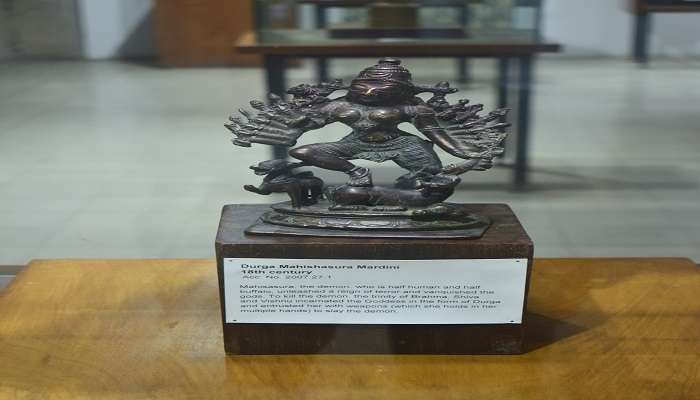
Located on the southern side of the rock hill, Caves III and IV are small and have the same shrines. Both of these share a single facade with two pillars and pilasters. Cave III is more significant as compared to the other and is a subsidiary shrine to the main rock-cut temple. This cave is dedicated to the notable profile of Durga Mahishasurmandini in the sanctum, but it is damaged. Cave IV has a square pitha for the Shiva linga, which is now lost. It also has traces of padma-pitha of a four-armed Vishnu in the north and four-armed Brahma in the south.
4. Cave V
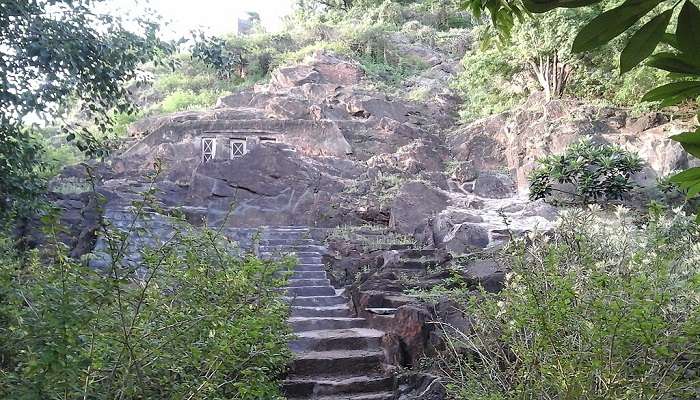
Located on the northern side of the rocky hills, Cave V is unfinished in comparison to the others. This cave has an area of about 26.5 feet by 5.5 feet, with three cube-shaped sanctums of 7.5 feet each. This cave mainly has traces of some animal figures. Of all the carvings, only eight can be traced clearly while the others faded over time. The floor of this cave was recently restored in 1981 with a thin layer of plaster poured on it.
Suggested Read: Temples In Vijayawada
Spots Near Mogalarajapuram Caves
After you are done exploring the ancient Mogalarajapuram Caves in Vijayawada, you can visit the beautiful attractions located nearby, such as:
1. Sri Nagarala Sri Maha Lakshmi Ammavaru Temple
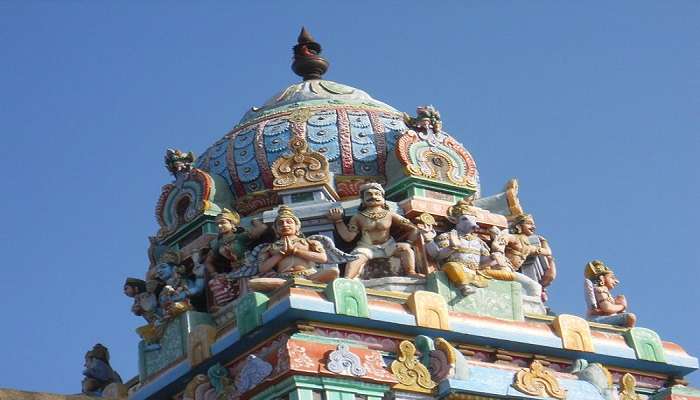
Sri Nagarala Sri Maha Lakshmi Ammavaru Temple is located in the Chittinagar district of Vijayawada. It is one of the most famous temples in the city. The temple is named after a community that takes care of the maintenance of this temple, named Nagarala. Dussehra is one of the most prominent festivals celebrated here. Thousands of devotees and tourists gather here at that time of the year to witness the magical experience. The temple is built over a large area and can easily gather many devotees. It has a neat and clean infrastructure, which tends to be a great attraction for visitors from abroad. During the evening aarti, the temple gets crowded with many devotees to offer their prayers. It would help if you experienced this divine place.
2. Bhavani Island
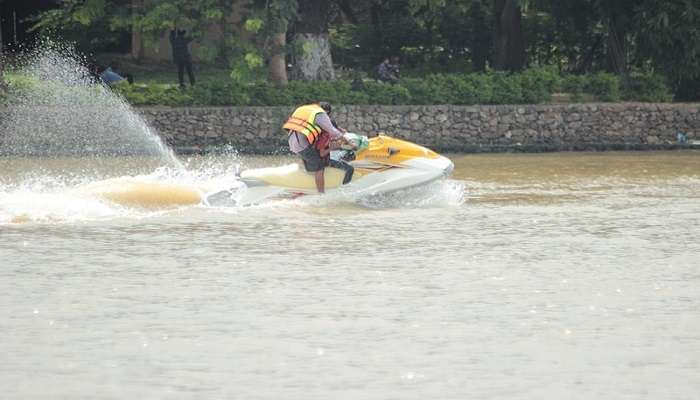
Bhavani Island lies in the midstream of the River Krishna, covering an area of 133 acres. If you get bored wandering around archaeological sites and are looking for something to do that’s seriously exciting, this island has learned to offer its visitors some stimulating water activities. You may choose from a wide variety of activities such as ski boats, jet boat rides, pedal boats, banana boats, swan boat rides, bumper boats, or fishing. Excitingly, this island offers a floating restaurant where you can enjoy meals with your family and friends while floating over the river. You may also roam around a leisure boat to cherish the moments.
Further Read: Shopping In Vijayawada
In Andhra Pradesh, Vijayawada is a place that offers a variety of options for visitors to travel. From historical sites like Mogalarajapuram caves to Mahalakshmi temple. The Mogalarajapuram caves are a perfect spot to visit if you are a history enthusiast. Even though a few sculptures have gouged out due to wear and tear over the years, the cave still has a lot to explore. Famous for being the only Ardhnareshwar idol in south India, this place holds a lot of significance for all the visitors. So, if you are planning a trip to Vijayawada do not forget to plan a visit to Mogalarajapuram Caves.
For our editorial codes of conduct and copyright disclaimer, please click here.
Cover Image Credit: Krishna Chaitanya Velaga for Wikimedia Commons .
Frequently Asked Questions About Mogalarajapuram Caves
Where are Mogalarajapuram Caves located?
Mogalarajapuram Caves are located in Vijayawada, Andhra Pradesh. It is situated near the left bank of River Krishna.
Is there any entry fee for Mogalarajapuram Caves?
There is an entry fee of Rs. 3 for every visitor at the Mogalarajapuram Caves. Regardless of age, it is the same for all.
What are the timings of the Mogalarajapuram Caves?
The cave opens at 9 am and closes at 6 pm every day. It gets a little busy during the evening.
Best time to visit Mogalarajapuram Caves?
The best time to visit the cave is between July to December. The weather is favourable at this time and is the best time to travel around.
What is the best time to visit Vijayawada?
The best time to visit Vijayawada is from October to March when the weather is pleasant for sightseeing. This period avoids the extreme heat of summer and heavy monsoon rains.
People Also Read:
Lahesh Caves Budher Caves Ajanta Ellora Caves

With a passion for exploring and travelling to the roads long forgotten, experience the world through enthralling stories and adventures. Join me as I share my experiences at some of the world’s most popular tourist destinations and quench that pestering curiosity with something exciting!











